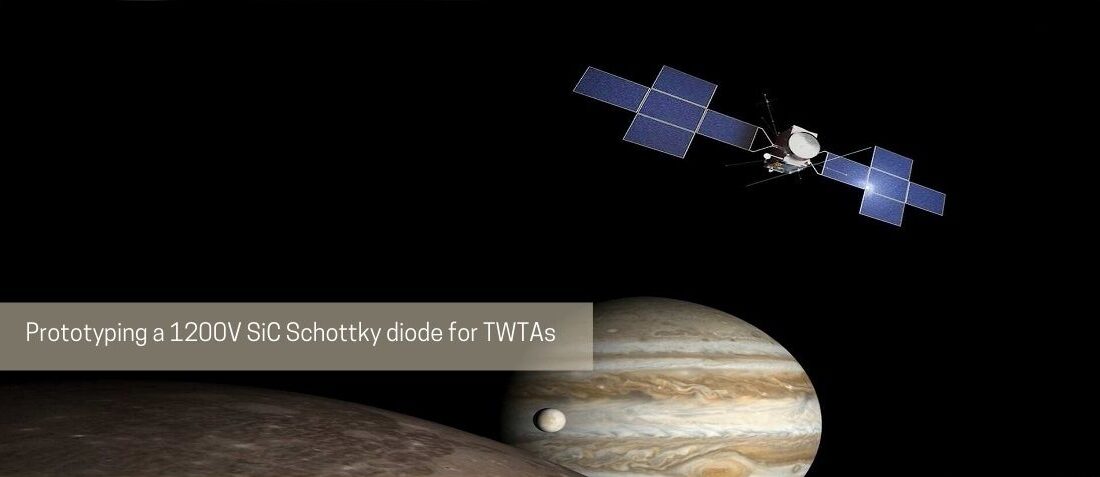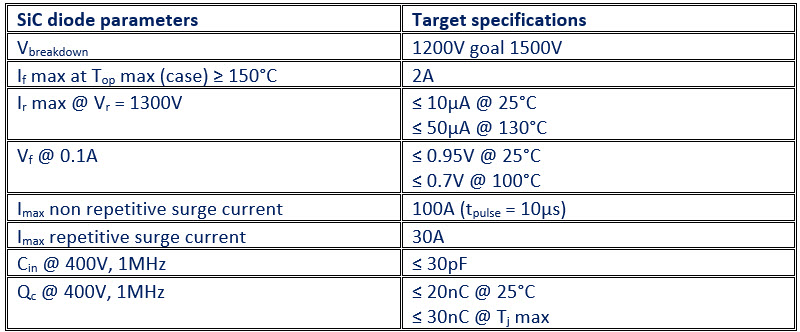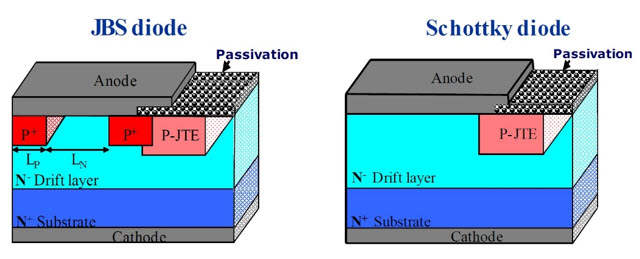
Prototyping a 1.2kV SiC Schottky diode for TWTAs
- Posted by Javier Alejandro de la Ossa Fernández
- On November 29, 2021
- 0
A new generation of electronic space units
In satellite transponders, where input signals are very weak and the output signals need to be high power, TWTAs (Travelling Wave Tube Amplifier) systems are commonly used. A TWTA is made up of two units: The travelling wave tube (TWT) as power amplifier and the electronic power conditioner (EPC), which adapts the main bus supply to the TWT, and telecommunication satellites can contain several of these sets! So, as you can imagine, any topological simplification and reduction of mass per set is desirable, and even more if we do not have to sacrifice performance.
The price tag for sending 1 kg to outer space is over a million dollars. The cost of mass is so expensive, and that means that if you can significantly decrease the mass of your system, you’ll be saving a significant amount of money.
An EPC typically operates under a baseplate temperature around 65°C; however, TWT is exposed to baseplate temperatures around 95°C. So, with the aim of improving satellite’s system design, increased operating temperature for the EPC, using SiC semiconductors, allows a distance reduction between EPCs and TWTs and therefore, reducing size and mass, maximizing efficiency, increasing the system reliability and durability, and even more important, reducing costs.
Compared with traditional silicon-based technology, the use of wide-bandgap materials, such as SiC, enables higher switching speeds and higher breakdown voltages, allowing for smaller, faster, more reliable, and more efficient power devices, and that’s why its interest in Space applications, where the operating conditions are extreme (high temperature and high radiation levels), is growing fast.
This first article will be part of a series related to a study that made part of the Work Plan of the Basic Technology Research Programme (TRP) funded by ESA, concretely in the category of technology push for a new generation of electronic space units.
Today, we will be covering the technical issues encountered during the critical analysis of designing a SiC diode in order to comply the optimized performances needed for the rectifier module in a next generation of EPCs for TWTAs.
The following table contains the specification requirements that the new diodes should meet to represent an improvement respect to the silicon-based diodes that are being used nowadays in high voltage rectifier modules inside EPCs.

Tabla 1. Electrical SiC diodes requirements
Firstly, regarding switching performances, the new diodes will require a near zero recovery current and reverse recovery time.
Secondly, the key parameter for these devices was the forward voltage drop at IF = 0.1A and Ta = 100°C. However, a low leakage current (10µA) at 1200V was considered as well, and it was necessary to deal with a low input capacitance (Cin) and a short switching turn-off time. These last two requirements there will not improve without minimizing the diode area, which do not benefit at all the forward voltage drop and the surge current capabilities.
To meet these criteria, two different types of diodes were considered, a pure Schottky and a Junction Barrier Schottky (JBS). A cross-section of both diodes is shown in the images below.

Left to right: Schematic cross-section of a Schottky diode and a JBS diode, including high voltage termination (JTE)
The only difference that can be found are the P+ rings included in the JBS active part. The P/N ratio that relates the P+ ring width (Lp) and the distance between both rings (LN), is a key parameter in JBS morphological designs.
All this said, two JBS diodes with two different Schottky barrier heights were designed, finding the following results:
- The JBS with the higher barrier configuration did not meet the forward voltage specifications.
- The JBS with the lower barrier configuration did not meet the reverse current specifications.
So, in conclusion, implementing a Schottky contact with a barrier height in between would be the ideal solution, but since this is not obvious as usual metals used in Schottky contacts have either lower (Ti, W, Mo) or higher barrier (Ni, Al, Au), different JBS LN/Lp relations were also tested, showing some different distributions of forward voltage drop versus reverse leakage current.
Finally, comparing with the existing commercial technologies, this is mixed of innovation and trade-off that was proposed:
- Use of JBS diodes for higher reliability and current peak capabilities.
- Tungsten (W) based Schottky metallization instead of titanium (Ti).
- Top metallization layer optimization for increasing current peak capabilities.
- Schottky metallization edge design optimization to withstand a maximum transient peak current.
- Use of optimal starting materials from European suppliers.
The table below summarizes the trade-off influence between forward voltage drop, reverse leakage current, and switching time regarding the three main design technology parameters.

Tabla 2.Trade-off conditions
Wrapping Up
In this first article, we’ve contextualized the importance of SiC devices in the power electronics field and how this can be particularly useful in space applications, and also, we set the foundations for a SiC diode that complies with the optimized performances needed for the rectifier module in the next generation of EPCs for TWTAs.
In the next future, we will analyse the static electrical characterization of this diode. If you cannot wait for it, click on the following link, and download the full paper of this study.
Alter Technology, and CNM (Spain National Centre of Microelectronics) have developed SiC Schottky diodes with special packages that offer, in addition to SiC advantages, high junction temperatures, up to 330 degrees Celsius, and protons and gamma radiation tolerance. These components are a perfect solution for high-frequency or complex switching power space applications, and they have already been used successfully in ESA projects. For more information, please do not hesitate to contact us.
Read more related in this post
- Entangled photon sources for quantum communications - December 14, 2022
- Using optical transceiver technology within space vehicles - November 8, 2022
- Issue 224 of ESCC QUALIFIED PART LIST (QPL) - March 21, 2022

0 comments on Prototyping a 1.2kV SiC Schottky diode for TWTAs